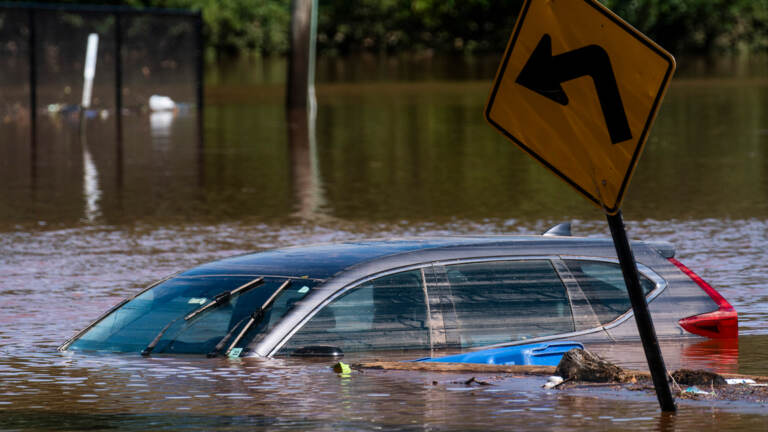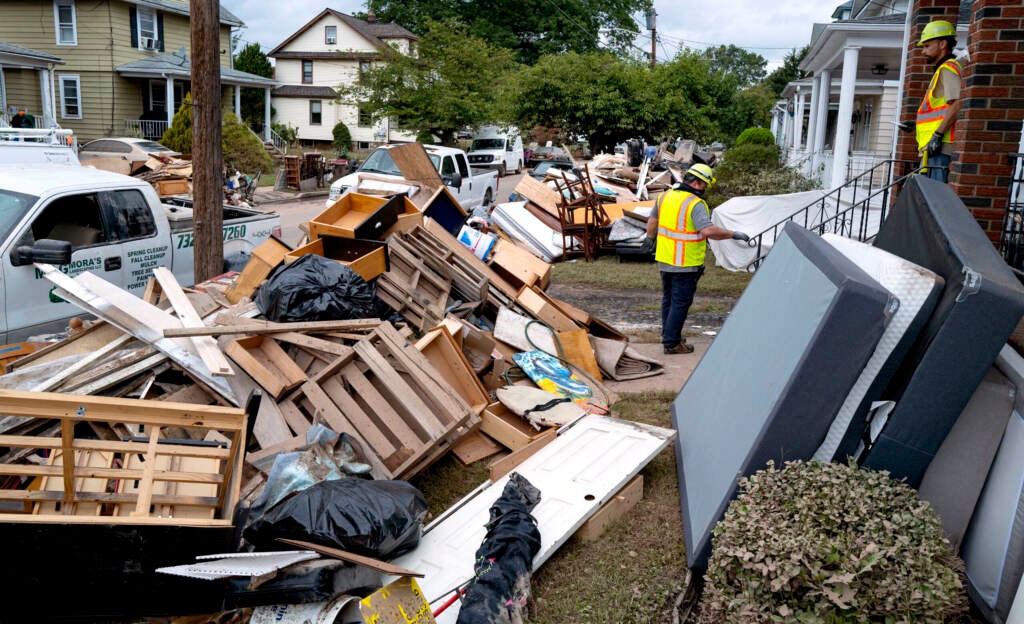Gov. Murphy announces big boost for flood buyouts
NJ to use federal money to buy properties damaged by Ida.

A car caught in a flooded road in Somerville in Tropical Storm Ida. (AP Photo/Eduardo Munoz Alvarez)
This story originally appeared on NJ Spotlight
The Murphy administration is targeting $50 million in federal aid to buy out properties flooded out last fall by Tropical Storm Ida — an event that reinforced the state’s vulnerability to climate change.
Gov. Phil Murphy made the announcement Tuesday in Lambertville, one of the areas hardest hit by Ida when a normally placid Swan Creek swelled so quickly after rains fell at the rate of 2 to 3 inches per hour, that it swept two houses into its waters.
The remnants of Ida unleashed strong winds and scattered tornadoes, and extreme flooding damaged homes, public facilities and other structures around the state. At least 29 were killed due to the storm last September.
The $50 million investment in the Blue Acres Buyout Program is the initial phase of Murphy’s Ida recovery strategy that aims to maximize all federal Ida disaster recovery into several programs that will launch over the coming months.
In addition, new community stormwater assistance grants totaling $10 million are available. Runoff from storms is one of the major problems degrading water quality around the state.
Blue Acres in high demand
The Blue Acres program is popular, but advocates say too little has been allocated to the buyouts in recent years. The program allows homeowners to sell flood-damaged or flood-prone properties at a market price to the state. In turn, the program demolishes the properties, and the land is preserved for open space, recreational purposes or preserved as wetlands.
“The demand for Blue Acres is oversubscribed by its current funding,’’ said Doug O’Malley, director of Environment New Jersey. “This will only intensify as extreme weather events increase.’’
“Today, we’re here to be more proactive. We are dealing with a new reality,’’ said Murphy on the property where the home of Nick Cepparulo once stood. He and his wife and two children had only five minutes to flee their home, which had to be demolished, according to Cepparulo.

The federal money targeted at the Blue Acres program, Murphy said, will allow homeowners in communities like Lambertville to facilitate market-rate purchases of properties that have experienced repetitive flood losses.
“Helping families relocate and turning these properties into open space will allow more floodwaters to be absorbed or diverted so that we don’t see the kinds of catastrophic losses we did during Tropical Storm Ida,’’ Murphy said.
So far, the Federal Emergency Management Agency has provided more than $247 million in individual assistance to 44,866 New Jerseyans impacted by Ida.
In addition to the new investment in Blue Acres, the Murphy administration is investing in what it calls a network of areas to help communities and economies in the face of a changing climate.
$1B in infrastructure investment
Among other things, the administration is working with the Army Corps of Engineers to steer new federal investment of over $1 billion in the study, design and construction of hard infrastructure projects in some of the state’s most flood-prone watersheds.
The state is modernizing its flood-hazard standards to include updated data on precipitation in New Jersey, junking dated information going back to 1999. Department of Environmental Protection Commissioner Shawn LaTourette said precipitation during heavy storm events is likely to increase between 2% and 10% as a result of climate change.
“New Jersey is ground zero for some of the worst impacts of climate change,’’ LaTourette said.
WHYY is your source for fact-based, in-depth journalism and information. As a nonprofit organization, we rely on financial support from readers like you. Please give today.







